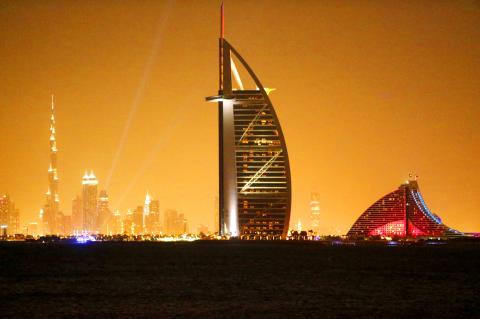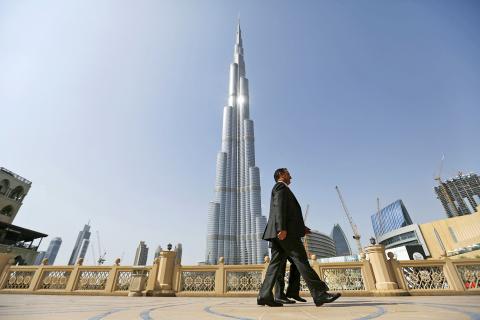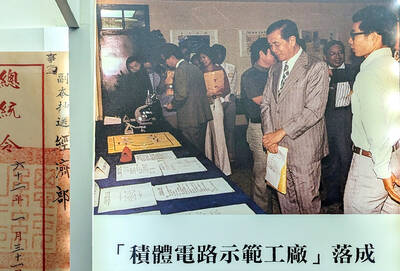If you’re visiting Dubai for a long stopover or business trip, make sure to leave a little space in your bag for a bathing suit, flip-flops and souvenirs.
For business travelers with just a few hours or half-day to spare in the emirate, head to the Dubai Mall. There, pick up a cold drink or frozen yogurt, and head outside to watch one of the world’s most beautiful dancing fountains and be mesmerized by base views of the world’s tallest tower, the Burj Khalifa.
If you feel like getting some exercise in, skip the hotel gym and head out for a run or brisk walk by Kite Beach, where a safe 5km track runs along the coast. Don’t forget to stop and take a selfie on the beach with the sea and Dubai’s iconic sail-shaped Burj al-Arab hotel behind you.

Photo: Reuters
For spinning enthusiasts, head to Fly Dubai where there’s no membership cost. Just call ahead to book a bike at one of Fly Dubai’s two locations for indoor spinning classes, but make sure to order a taxi ahead of time if you go during peak rush hours. The metro does not connect to either location and taxis are hard to find between 4pm and 8pm.
For a quieter afternoon, head to Dubai’s man-made island, The Palm. Go for a day pass at the Atlantis or the Jumeira Zabeel Saray hotel. A day pass during the workweek, which in the Middle East runs from Sunday to Thursday, is significantly cheaper and the beach quieter than the weekend days of Friday and Saturday. Most hotels that offer day passes also include lunch.
FINDING SERENITY

Photo: Bloomberg
If what you need is a few, short hours of complete serenity to clear your head, go for the ultimate pampering experience and head to the spa at the One and Only Royal Mirage across from Dubai Media City or the Talise Spa in Madinat Jumeirah.
Once at Madinat Jumeirah, shop in its famous souq where you can pick up some reasonably priced souvenirs like postcards and Middle Eastern-inspired printed artworks at Gallery One.
Unlike most Middle Eastern markets, this souq is indoors and there isn’t too much haggling over prices. The upside is that what the market misses in authentic folkloric experience it makes up for in air-conditioned comfort between the hot months of April and October.

Photo: Reuters
Also at the souq are some of Dubai’s most popular restaurants with views of the Burj al-Arab and a man-made waterway that connects the three hotels that comprise Madinat Jumeirah.
If you are in Dubai between November and March, when the weather is great outdoors, visit The Walk at Jumeirah Beach Residence, better known as JBR. There, visitors can soak up some sun on the beach, enjoy a lavish meal and shop for unique finds at boutiques like Sauce — a homegrown chain of edgy concept stores in Dubai.
The hotels along The Walk are home to some of Dubai’s best restaurants, but meals there don’t come cheap. For something a little less formal, enjoy a bite to eat at one of JBR’s many outdoor cafes and restaurants. At night on the weekends, JBR turns into a bustling street for people watching. The Gulf’s wealthy cruise along the strip in their Ferraris, Lamborghinis, Rolls-Royces and Bentleys.
Nearby are some of the world’s most architecturally stunning skyscrapers in Marina. There, too. you’ll find a mall, outdoor cafes and some of the city’s most expensive real estate overlooking the yachts.

Oct. 27 to Nov. 2 Over a breakfast of soymilk and fried dough costing less than NT$400, seven officials and engineers agreed on a NT$400 million plan — unaware that it would mark the beginning of Taiwan’s semiconductor empire. It was a cold February morning in 1974. Gathered at the unassuming shop were Economics minister Sun Yun-hsuan (孫運璿), director-general of Transportation and Communications Kao Yu-shu (高玉樹), Industrial Technology Research Institute (ITRI) president Wang Chao-chen (王兆振), Telecommunications Laboratories director Kang Pao-huang (康寶煌), Executive Yuan secretary-general Fei Hua (費驊), director-general of Telecommunications Fang Hsien-chi (方賢齊) and Radio Corporation of America (RCA) Laboratories director Pan

President William Lai (賴清德) has championed Taiwan as an “AI Island” — an artificial intelligence (AI) hub powering the global tech economy. But without major shifts in talent, funding and strategic direction, this vision risks becoming a static fortress: indispensable, yet immobile and vulnerable. It’s time to reframe Taiwan’s ambition. Time to move from a resource-rich AI island to an AI Armada. Why change metaphors? Because choosing the right metaphor shapes both understanding and strategy. The “AI Island” frames our national ambition as a static fortress that, while valuable, is still vulnerable and reactive. Shifting our metaphor to an “AI Armada”

When Taiwan was battered by storms this summer, the only crumb of comfort I could take was knowing that some advice I’d drafted several weeks earlier had been correct. Regarding the Southern Cross-Island Highway (南橫公路), a spectacular high-elevation route connecting Taiwan’s southwest with the country’s southeast, I’d written: “The precarious existence of this road cannot be overstated; those hoping to drive or ride all the way across should have a backup plan.” As this article was going to press, the middle section of the highway, between Meishankou (梅山口) in Kaohsiung and Siangyang (向陽) in Taitung County, was still closed to outsiders

The older you get, and the more obsessed with your health, the more it feels as if life comes down to numbers: how many more years you can expect; your lean body mass; your percentage of visceral fat; how dense your bones are; how many kilos you can squat; how long you can deadhang; how often you still do it; your levels of LDL and HDL cholesterol; your resting heart rate; your overnight blood oxygen level; how quickly you can run; how many steps you do in a day; how many hours you sleep; how fast you are shrinking; how